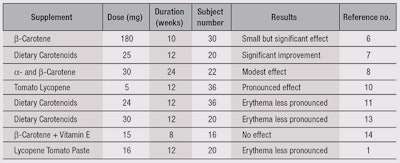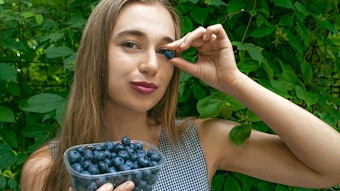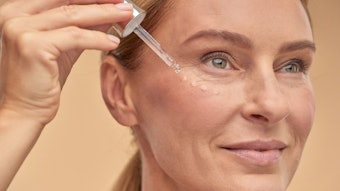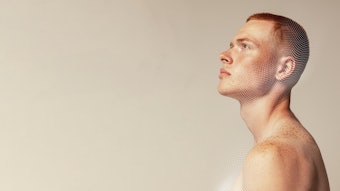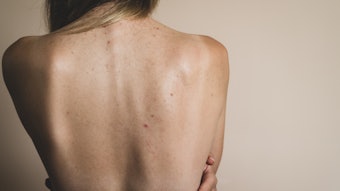
Human skin is continuously exposed to free radicals; not just ultraviolet (UV) solar radiation but the visible and infrared range of the spectra, as well. Sun exposure leads to the production of free radicals in the skin. These highly reactive molecules serve an important function in humans, acting against viruses and bacteria as well as processing signals on a cellular level. However, if the concentration of free radicals exceeds a critical level, cells and their compartments can be harmed. UV radiation is, in fact, a major cause for sunburn, photodamage, premature skin aging and skin cancer. Sun exposure also leads to damage in skin’s elastic fibers, i.e., elastin and collagen, resulting in premature aging.
The body’s own antioxidant systems can provide a complex defense against free radicals, counteracting their highly reactive and destructive effects and neutralizing them to prevent cell and tissue damage. Antioxidants in human skin include carotenoids and vitamins, as well as various enzymes. Since humans cannot produce these substances naturally, they must be supplemented in the diet, particularly in the form of fruits and vegetables. In fact, research has shown that individuals consuming high levels of fruits and vegetables rich in carotenoids have lower incidences of skin pathology. In vitro and in vivo evidence demonstrates the role of endogenous carotenoids in the systemic protection and maintenance of skin health.1-3 In this article, they are considered for potential photoprotection.
Chemistry of Dietary Carotenoids
Carotenoids are yellow, orange and red pigments synthesized by plants. Those most common in North American diets are α-carotene, β-carotene, β-cryptoxanthin, lutein, zeaxanthin and lycopene (see Figure 1). Most carotenoids have a polyisoprenoid structure with a long chain of conjugated double bonds and nearly bilateral symmetry around the central double bond. Carotenoids are tetraterpenoid compounds containing 40 carbon atoms arranged in a repeating pattern of five carbon units.
The conjugated polyene chromophore determines not only the light-absorption properties and color but also the photochemical properties of the molecule and consequent light-harvesting and photoprotective action. The polyene chain is mainly responsible for the chemical reactivity of carotenoids to oxidizing agents and free radicals, and hence for any antioxidant role.4 Structural features such as size, shape and polarity are essential determinants for the ability of a carotenoid to correctly fit into its molecular environment and function.
Carotenoids are divided into carotenes and xanthophylls. Carotenes contain only carbon and hydrogen, whereas xanthophylls contain carbon, hydrogen and oxygen. Major carotenoids found in human blood are β-carotene, α-carotene, lycopene, phytoene and phytofluene, as well as the xanthophylls lutein, zeaxanthin and α- and β-cryptoxanthin.
The photo-protective activity of carotenoids is related to their antioxidant properties. Singlet oxygen quenching by carotenoids occurs mainly via physical quenching, which involves the transfer of excitation energy from ¹O2 to the carotenoid, resulting in ground state oxygen. Energy is dissipated between the excited carotenoid and the surrounding solvent to yield thermal energy. In the process of physical quenching, the carotenoid remains intact and can undergo further cycles of singlet oxygen quenching, quasi-acting as a catalyst. β-Carotene and other carotenoids scavenge peroxyl radicals, especially at low oxygen tensions. Efficiency is more pronounced when mixtures of carotenoids are used, suggesting synergistic effects.2-5
Dietary Carotenoids and Photoprotection
The photoprotective effects of carotenoids have been investigated in humans using carotenoid supplements or carotenoid-rich fruits and vegetables as oral sun protectants. Several studies demonstrated the effects of carotenoids such as β-carotene and lycopene on the prevention of sunburn and skin damage, i.e., solar erythema formation. These studies are described here.
β-Carotene: Beginning in 1972, Mathews-Roth et al. held a clinical trial observing the effects of β-carotene on the responses of the human skin to solar radiation. Thirty Caucasian male volunteers were divided into C (carotene) and P (placebo) groups. The C group received β-carotene at 180 mg per day. Both groups were exposed to sunlight in the Arizona desert for up to 2 hr daily for 10 weeks. β-Carotene was found to have a small but statistically significant effect in increasing the minimal erythema dose (MED) of solar radiation.6
Carotenoids and vitamin E on erythema: In 2000, Stahl examined whether carotenoids alone or when mixed with vitamin E would protect against UV light-induced erythema in humans. Six men and 14 women, all Caucasian, were divided at random into two groups. Group one took a carotenoid supplement, 25 mg per day, while group two took a combination of the carotenoid supplement with vitamin E—i.e., 335 mg RRR-α-tocopherol per day for 12 weeks. Results showed that the erythema on dorsal skin was diminished after week eight (p < 0.01) and that the supplement with vitamin E was more effective than just the supplement alone. Ultimately, the antioxidants used were effective for lowering sensitivity to UV light.7
α- and β-Carotene: Also in 2000, Lee et al. determined the magnitude of the protective effect of oral α- and β-carotene supplements for 24 weeks on UVA- and UVB-induced erythema in humans. While being exposed to UVA and UVB radiation, 22 subjects, 11 men and 11 women, received natural carotenoids for 24 weeks. The subjects were given 30 mg of carotenoids for the first eight weeks, then the dose was progressively increased by 30-mg increments every eight weeks, from 30 mg to 90 mg. Their MED from solar simulator radiation increased significantly (p < 0.05), suggesting that supplementation with natural carotenoids may partially protect human skin from UVA- and UVB-induced erythema, although the magnitude of the protective effect was modest.8
β–Carotene vs. carotenoid blend: In 2003, Heinrich et al. compared the effects of a 24 mg β–carotene supplement per day to the effects a blend of three carotenoids: β-carotene, lutein and lycopene, 8 mg each/day; along with a placebo as control. Twelve men and 24 women were divided into three groups, each given a different supplement at random for 12 weeks. Blood serum and skin levels of carotenoids were measured at baseline, week six and week 12. After irradiation with a solar simulator, both carotenoid-treated groups experienced efficient decreases in the intensity of erythema induced by UV-light exposure—i.e., significantly lower than the baseline. Using this method of UV protection shows more permanent results than do topical products.9
Pigmentation and photosensitivity: Subsequently, Heinrich and Stahl et al. tested whether dietary carotenoids influenced skin pigmentation and UV photosensitivity in a group of eight men and 14 women, all Caucasian. Dorsal skin was irradiated at multiple sites with varying doses of UV radiation using a solar simulator. Carotenoid levels were determined noninvasively, and skin color measurements were taken using a chromameter. The researchers found that b chromatogram values correlated with skin carotenoid levels at various sites, including the back, forehead, inner forearm and palm of the hand. Skin carotenoid levels and MED were correlated, as well as b values and MED, suggesting that the carotenoids contributed to human skin color and also that tristimulus b values may be a method to monitor carotenoid status and UV photosensitivity.10, 11
Synthetic lycopene and tomato extract: In 2003, Stahl et al. performed a study comparing the photoprotective effects of synthetic lycopene with that of a tomato extracta and a drink containing a solubilized version of the extractb. Thirty-six healthy adults took part, all Caucasian, and were divided into three groups. In the 12-week study, the lycopene group ingested two capsules of 10.2 mg synthetic lycopene per day. The tomato extract group ingested two soft gels containing tomato extract—i.e., 4.9 mg lycopene, 1.1 mg mixed carotenoids per capsule. The tomato extract drink group drank 250 mL of it twice daily—i.e., 4.1 mg lycopene, 4.1 mixed carotenoids per 250 mL. Each group took its respective supplements with their main meal.
At baseline, week four and week 12, erythema was induced using a light simulator. Their dorsal skin was irradiated with 1.25 MED, and a chromatogram values were used to evaluate erythema intensity. A decrease in the a value from baseline to week 12 was observed in all groups. However, the tomato extract and tomato extract drink groups experienced a higher percentage difference, 38% and 48% respectively, compared with the synthetic lycopene group, which experienced a 25% difference. Both of the tomato groups had the added benefit of phytofluene and phytoene, which may have contributed to protection since they both absorb UV light.
Duration of studies: Additionally, in 2004, Sies and Stahl published a review regarding the relation between carotenoids and UV protection, concluding that contradictory results existed but that protection was only determined in studies longer than 10 weeks. This is an important finding as it suggests that the effects of carotenoids on photoprotection require a long duration of clinical study design.9, 12, 13
Vitamin E and β–carotene on skin stress: In 2004, McArdle et al. observed the effects of vitamin E and β-carotene supplements on UV radiation-induced stress in human skin. The study was conducted with 16 subjects, allocated as two groups of eight. One group received vitamin E supplements, 400 IU α-tocopherol per day, and the other received β-carotene, 15 mg per day, for eight weeks. For those in the vitamin E group, concentrations of vitamin E increased in both the plasma and skin; for those in the β–carotene group, concentrations of β–carotene group only increased in plasma. The investigators concluded that vitamin E or β-carotene supplementation had no effect on skin sensitivity to UV radiation. Neither supplement affected other measures of UV radiation induced oxidative stress in human skin, which suggested no photoprotection from the supplementation. It should be noted that the study was only for eight weeks; as Sies and Stahl previously observed, photoprotective effects only appeared in studies longer than 10 weeks.14
Lycopene and photoprotection: In 2006, Stahl et al. published a review specifically analyzing the efficacy of lycopene in photoprotection. The study was with an all-Caucasian panel (n = 36) that consumed lycopene from different sources for 10 to 12 weeks. The study supplements were as follows: tomato paste, 40 g per day, 16 mg lycopene, 10 weeks; carrot juice, 2.5 mg lycopene, 1.3 β-carotene, 2 × 200 mL per day, 12 weeks; lycopene supplement; lycopene drink; and synthetic lycopene. Sampling times were at baseline, week four and week 12; or at baseline, week four and week 10, for the tomato paste study. At week four, basal levels of lycopene in their serum peaked, and at the end of the studies, basal levels were from 1.5–2× higher; however, skin levels were less affected, elevated only 1.2–1.4× higher. Regarding photoprotective effects, the tomato paste showed a 40% lower value from baseline to week 10, while the carrot juice showed a 45% decrease in skin redness, demonstrating the effect of lycopene on photoprotection.15, 16
Carotenoids and flavonoids: In 2007, Stahl and Sies reviewed the efficacy of carotenoids and flavonoids for photoprotection. Their previous studies demonstrated the potential of flavonoids in preventing damage from sunlight.
In another study, these researchers examined whether high-flavanol cocoa provided photoprotection against UV-induced erythema. Volunteers consumed high or low flavanol—i.e., 326 mg/day or 27 mg/day, respectively, of cocoa powder in 100 mL of water over 12 weeks. Erythema was reduced by 50% and 70% after six and 12 weeks, respectively, in the high-flavanol group, while there was no change in the low-flavanol group. They concluded that the flavanols of the cocoa contributed endogenous photoprotection and improved dermal blood circulation.17
As summarized in Table 1, studies suggest that systemic supplementation of the diet with carotenoids leads to protection from erythema, a decrease in wrinkling and healthier skin in general, and carotenoids supplemented through the diet may be suitable compounds for photoprotection in humans. With additional protection from carotenoids, less redness was observed from UV-induced erythema in skin. Therefore, β-carotene and other carotenoids (such as lycopene, lutein, phytoene and phytofluene) can be used as photoprotectants.
Topical Applications
A recent study looked at carotenoid levels in the skin of 129 women (ages 21–72) after using carotenoids topically and systemically. The women were divided into seven groups and given topical creams, oral supplements, both or a placebo. The first cream contained a basic mixture of antioxidants from sources such as vitamin E, vitamin C and green tea; the second cream was the same antioxidant mix complemented by β-carotene and lycopene. Similarly, the first supplement contained antioxidants from sources including green tea, green coffee and Pongamia pinnata seeds, while the second contained these antioxidants plus carotenoids.
The placebo treatments did not increase the carotenoid concentration in the skin, while the carotenoid cream increased it by 30% in the forehead and 35% in the cheeks. Taking the antioxidant supplement containing carotenoids resulted in an 80% increase in the forehead and 70% increase in the cheeks after just four weeks. The most interesting results were from the group that used both creams and supplements. After four weeks, results were similar to those of the group using only supplements; in fact, the supplement-only group actually scored better in some areas. After eight weeks, the group using both antioxidant plus carotenoid supplements and creams had the best results. However, use of the antioxidant cream without carotenoids, along with the antioxidant plus carotenoid supplement, gave poorer results than the supplement alone. In other words, using the cream somehow negated some of the supplements’ benefits. This also suggested that topical antioxidants may increase the stability of carotenoids absorbed through a normal diet.
According to the authors, it is possible that systemic antioxidants were absorbed and transported onto the skin surface with sweat and sebum, and that applying the cream did not increase the concentration any further. This is because the stratum corneum acts as a reservoir for topically applied carotenoids. Hence, when one applies a cream, it penetrates into this layer and saturates the reservoir, which makes it impossible for systemically absorbed antioxidants to penetrate into the same layer through sweat and sebum. The authors stated that compared to taking only an oral supplement, taking a supplement and applying a cream resulted in a lower carotenoid concentration. To avoid this problem, they suggest that the topical cream be formulated so as not to saturate the reservoir and prevent oral antioxidants from being transported into the skin; in effect, they advise against using lipid-rich formulations.
The use of antioxidants in sunscreens as stabilizers also may be effective. The Universitätsmedizin Berlin group showed that carotenoids act as stabilizers in sunscreen formulations against oxidation. As well as increasing skin protection against the destructive actions of free radicals, carotenoids substantially increase the working life of cosmetic formulations. Further, carotenoids also are effective anti-aging compounds. High concentrations make the skin thicker, more elastic and less likely to wrinkle. Thus, for all-over healthy skin, carotenoids are extremely effective.18, 19
Therapeutic Uses
One of the functions of carotenoids pigments in green plants and photosynthetic microorganisms is to protect these organisms against photosensitization by their own chlorophyll. Therefore, carotenoids such as β-carotene and canthaxanthin have been suggested for the treatment of photosensitivity associated with the rare genetic disease erythropoietic photoporphyria (EPP) and certain other photosensitivity diseases of the skin. No serious toxicity has been reported. These carotenoids most likely perform the protective function by quenching excited species formed by the interaction of porphyrins or other photosensitizers, light and air, thereby preventing the cellular damage that leads to the symptoms of photosensitivity.20, 21
Conclusion
Carotenoids are versatile and among the most efficient natural scavengers of free radicals. Overall, long term supplementation with high doses of a mixture of naturally occurring carotenoids modestly raised MED, and therefore may reduce the risk of sunburn. They may be used as oral sun protection, as carotenoids lessen the damage of UV-induced erythema and contribute to life-long protection from damaging effects of sunlight. Although oral sun protection is useful in a more permanent manner, sunscreens are still essential. Carotenoids are used in sunscreens to stabilize the formulas. Their antioxidant properties also protect formulations against oxidation and substantially increase their working life.2, 22 In spite of the extensive experimentation documented here, much remains to be done in several areas, including public health, before carotenes are welcomed into mainstream medicine.
References
- SK Thakkar, AM Moodycliffe and M Richelle, Carotenoids and skin, in Nutrition and Skin, Springer Science + Business Media, Dordrecht, Netherlands, ch 5 (2011) pp 59-78
- ME Darvin, W Sterry, J Ladermann and T Vergou, The role of carotenoids in human skin, Molecules 16, 10491-10506 (2011)
- W Stahl and H Sies, Photoprotection by dietary carotenoids: Concept, mechanisms, evidence and future development, Mol Nutr Food Res 56, 287-295 (2012)
- G Britton, Structure and properties of carotenoids in relation to function, The FASEB Journal 9 1551–1558 (1995)
- www.photobiology.info/Solovchenko.html (Accessed Feb 11, 2014)
- MM Mathews-Roth et al, A clinical trial of effects of oral beta carotene on the responses of human skin to solar radiation, J Invest Derm 59(4) 349–353 (1972)
- W Stahl, U Heinrich, H Jungmann, H Sies and H Tronnier, Carotenoids and carotenoids plus vitamin E protect against ultraviolet light-induced erythema in humans, Am J Clin Nutr 71 795-798 (2000)
- J Lee, S Jiang, N Levine and RR Waston, Carotenoid supplementation reduces erythema in human skin after simulated solar radiation exposure, Proceedings of the Society for Experimental Biology and Medicines 223 170–174 (2000)
- U Heinrich, C Gärtner, M Wiebusch, O Eichler, H Sies, H Tronnier and W Stahl, Supplementation with beta-carotene or a similar amount of mixed carotenoids protects humans from UV-induced erythema, J Nutrition 133 98–101 (2003)
- S Alaluf et al, Dietary carotenoids contribute to normal human skin color and UV photosensitivity, J Nutrition 132 399-403 (2002)
- O Aust, W Stahl, H Sies, H Tronnier and U Heinrich, Supplementation with tomato-based products increase lycopene, phytofluene and phytoene levels in human serum and protects against UV-light-induced erythema, Intl J Vitamin Res 3(224) 1-7 (2003)
- H Sies and W Stahl, Nutritional protection against skin damage from sunlight, Annu Rev Nutr 24 173–200 (2004)
- H Sies and W Stahl, Carotenoids and UV protection, J Royal Soc Chem and Owner Societies 3 749–752 (2004)
- F McArdle et al, Effects of oral vitamin e and beta carotene supplementation on ultraviolet radiation-induced oxidative stress in human skin, Am J Clin Nutr 80 1270–1275 (2004)
- W Stahl, U Heinrich, O Aust, H Tronnier and H Sies, Lycopene-rich products and dietary photoprotection, Photochem Photobiol Sci 5 238–242 (2006)
- O Aust et al, Supplementation with tomato-based products increases lycopene, phytofluene, and phytoene levels in human serum and protects against UV-light-induced erythema, Int J Vitam Nutr Res 75(1) 54–60 (2005)
- W Stahl and H Sies, Carotenoids and flavonoids contribute to nutritional protection against skin damage from sunlight, Mol Biotechnol 37 26–30 (2007)
- ME Darvinet al, Dermal carotenoid level and kinetics after topical and systemic administration of antioxidants: Enrichment strategies in a controlled in vivo study, J Derm Sci 64 53–58 (2011)
- ME Darvin et al, Topical beta-carotene protects against infra-red-light-induced free radicals, Exp Derm 20 125–129 (2011)
- MM Mathews-Roth, Therapeutic uses of carotenoids in skin photosensitivity diseases, in Skin Photosensitivity Diseases, Marcel Dekker, NY (2004) pp 519-529
- CH Bayerl, Beta carotene in dermatology: Does it help? Acta Dermatoven> APA 17(4) 160–166 (2008)
- W Stahl and H Sies, Beta carotene and other carotenoids in protection from sunlight, Am J Clin Nutr 96 (suppl) 1179S-1184S (2012)
